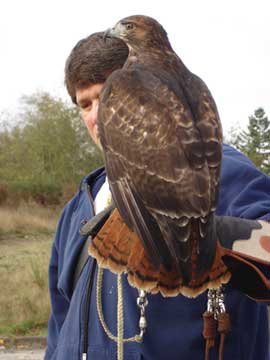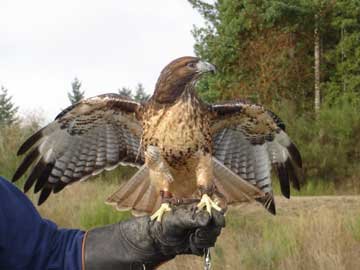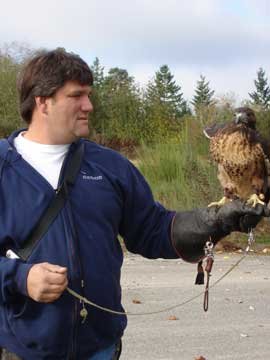 Dean Johnson shows off Gremlin's red tail feathers. Photo by Colleen Slater
Dean Johnson shows off Gremlin's red tail feathers. Photo by Colleen Slater
As a child, Dean Johnson brought home injured animals and birds needing care. One day as an adult, he was out working and saw a red-tailed hawk with both feet injured. He took the bird home to nurse it back to health.
After being released, she flew off, but returned to the area, and Johnson with his wife, Kathy, often see her in the surrounding trees. She apparently nests and raises her young there. They identify her from one toe upraised, “like she’s sipping tea,” says Kathy. That toe was unable to be worked into the healing cast Johnson applied.
Caring for this hawk, Johnson learned about the Washington Falconry Association, and decided to become an apprentice falconer. This required obtaining state and federal permits, building housing with an outside weathering area, and learning more about falcon care. Johnson has been an apprentice falconer for two years, and will complete his apprenticeship next spring.
The housing, 12 by 12 by 12 feet, with one window, is called a mew. The weathering area is surrounded and covered with a particular kind of wire. Johnson’s mew is carpeted to keep the birds talons sharp.
 Dean Johnson shows off Gremlin. Photo by Colleen Slater
Dean Johnson shows off Gremlin. Photo by Colleen Slater
Gremlin, the red-tailed hawk Johnson currently has, was captured in the wild, with a rodent in the trap. When trapped, the young bird is placed in the mew, with the window covered, and food pushed through a trap door. The falconer steps into the mew to “get acquainted” and gradually spends more time with the bird, until it is used to his presence. This may take from a few days to two weeks.
“Gremlin calmed fast for a wild bird,” Kathy says.
The Johnsons bring Gremlin inside their home to watch television with them on a regular basis, but have to cover the interior of the room with plastic. “She’s pretty good,” notes Kathy. Gremlin even squats to “do her business,” but some birds can send a stream of droppings some distance.
Johnson takes Gremlin hunting at least once a week to areas where he knows there are rodents and rabbits. Gremlin flies to a tree, and Johnson beats the brush to stir up the small animals. The hawk will return to his arm at a whistle command, as she’s been trained.
 Dean Johnson with Gremlin. Photo by Colleen Slater
Dean Johnson with Gremlin. Photo by Colleen Slater
The practice of capturing these birds and nurturing them to maturity is done to increase the population, which seems to rapidly diminish in the wild. The falconry program, with active chapters in Port Orchard, Tacoma, and Graham, has recorded increased numbers of red-tailed hawks and other native birds of prey.
Johnson raises rabbits and pigeons to feed the hawk, but buys the rats used for food.
When the time for release of the bird nears, it is kept in the mew with darkened windows, and the falconer gradually withdraws, throwing in the food. Johnson will release Gremlin in the area where she was captured.
After the forced captivity in the darkened mew, without human contact, the birds readily fly to freedom. The falconer feels the emotional break more than the bird, but he will capture another young one soon, and spend a year becoming attached to that one.
UNDERWRITTEN BY THE FUND FOR NONPROFIT NEWS (NEWSMATCH) AT THE MIAMI FOUNDATION, THE ANGEL GUILD, ADVERTISERS, DONORS AND PEOPLE WHO SUPPORT INDEPENDENT, NONPROFIT LOCAL NEWS